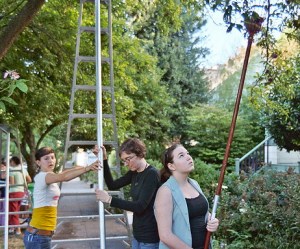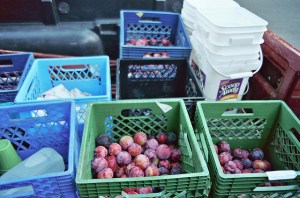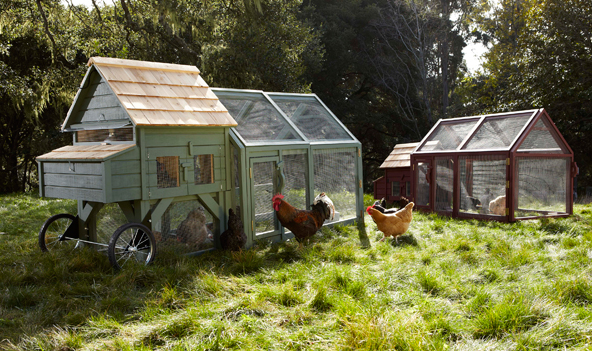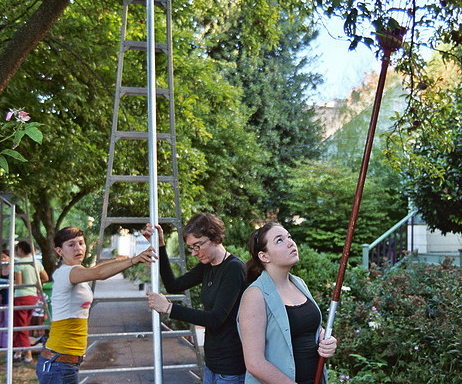This post originally appeared on Shareable.

A Portland Fruit Tree Project harvesting party. (Photo by Sarah Gilbert.)
Foraging for food — whether it’s ferreting rare mushrooms in the woods, picking abundant lemons from an overlooked tree, or gathering berries from an abandoned lot — is all the rage among the culinary crowd and the DIY set, who share their finds with fellow food lovers in fancy restaurant meals or humble home suppers.
But an old-fashioned concept — gleaning for the greater good by harvesting unwanted or leftover produce from farms or family gardens — is also making a comeback during these continued lean economic times.
In cities, rural communities, and suburbs across the country, volunteer pickers join forces to collect bags and boxes of fruits and vegetables that find their way to homeless shelters, soup kitchens, and food pantries, as well as senior centers, low-income homes, and school lunch programs.
Where some may see excess, others see opportunity — the chance to make a difference, feed the hungry, and avoid waste. It’s a win-win-win all round: Growers who have surplus or seconds find a good home for these edibles beyond the compost pile; financially strapped aid organizations get much-needed fresh food for free for their patrons; and the gleaners get to give back in their communities. “I’ve been surprised at how emotionally rewarding this is,” says Andrew Sigal, an avid gardener in Oakland, Calif., who started Food Pool last summer to share the abundance from his prolific 800-square-foot garden with local food pantries. “It’s one thing to give someone in need a dollar or a donation, but seeing someone get excited about beans from my backyard has been deeply fulfilling.”
Some gleaners have even made a national name for themselves. Take The Lemon Lady, aka Anna Chan, a stay-at-home mom who began collecting excess fruit in suburban Clayton, Calif., while driving her then-baby daughter around to nap. Chan, who knew hunger as a child and how it felt to wait in food lines for canned goods, was shocked to see so much fresh fruit — such as oranges, apricots, and apples — left rotting in her neighbors’ front yards, so she started a single-handed campaign to do something about it.
Three years on and hundreds of tons of produce later, Chan, who is now a regular fixture at local farmers markets where she collects unsold fruits and vegetables that she hauls to a local food pantry and Salvation Army site, has been featured in People, The Huffington Post, and Civil Eats. While the press attention has helped her cause, she keeps a laser-like focus on her mission to feed those in need. “Many people don’t know where their local food pantry is located and don’t realize that food banks will gladly take fresh produce,” says Chan, who encourages people to get started by picking excess fruits and veggies in their immediate area and passing it on.

Portland Fruit Tree Project foragers collect plums using old sheets. (Photo by Sarah Gilbert.)
From California to New York and places in between, communities are finding creative, local ways to get fresh food to the residents who have the most challenges accessing such food. Glean for the City in Washington, D.C., for example, has a three-pronged approach: picking surplus produce from regional farms, gathering leftover greens from farmers markets, and harvesting excess residential edibles.
Since 1988, Friendship Donations Network (FDN) in Ithaca, N.Y., has worked with local farmers to “rescue” thousands of pounds of produce that would otherwise go to waste and to distribute it to low-wage workers, the elderly, and the young. Gleaned produce donated by the organization serves 24 programs that feed more than 2,000 people a week. The model just makes sense, says FDN program coordinator Meaghan Sheehan Rosen, who points out that there’s no reason perfectly good food should go uneaten if farmers are willing and people are needy.
Some gleaning efforts have grown out of religious organizations — not surprising, since the term has biblical origins. In the Book of Ruth, for instance, the poor are permitted to pick grain left over from the harvest. The Society of St. Andrew, based in Virginia, has gleaning groups in several states including Arkansas, Illinois, Michigan, Ohio, and Pennsylvania that have collectively gleaned millions of pounds of produce. Faith Feeds, a Lexington, Ky., gleaning group that grew out of a church meeting, has picked up more than 111,000 pounds of produce since the summer of 2010, from farmers markets, farms, and private residences. “It is not hard to feed the hungry,” says Jennifer Erena of Faith Feeds, an interfaith group not affiliated with any particular religion or church. “The word is spreading and there’s a wonderful energy among different people and organizations that is both collaborative and community oriented.”
There are gleaning programs that connect homeowners overwhelmed by an abundant harvest with volunteers willing to pick produce and take it to local food banks, such as Portland Fruit Tree Project in Oregon. But many gleaning efforts are simply started by an individual who sees a need and wants to fill it. “I particularly like picking fruit for seniors, many of whom can no longer climb a ladder or aren’t able to do physical labor anymore,” says North Berkeley Harvest founder Natasha Boissier, who started solo but now works with a group of volunteers. “They come out and talk with me while I work, and I appreciate and respect their wisdom and experience, and hearing about the ups and downs of having lived life. These moments of connection have brought me — and I hope them — a great deal of unexpected joy.”
Boissier’s first stop with fresh food is often the local men’s shelter. “These men are often blamed for what’s wrong with them,” says the clinical social worker. “I see them early in the morning standing out in the cold after enduring a night of who knows what and I want to give them a piece of fruit to offer a moment’s respite from their pain and suffering. That’s my hope: to provide something tangible, simple, and sweet in their lives.”

Portland Fruit Tree Project plums get distributed to those who have less access to fresh food. (Photo by Sarah Gilbert.)
Some gleaning programs have become an integral part of their community. Take the Novato Schools Gleaning Program. Every week for the past six years, parents, students, and members of this Marin County, Calif., community glean excess organic produce from a participating local farm. (There are about 15 in the program.) Through a partnership with Marin Organic, a cooperative association of local growers, fresh chard picked by a volunteer on Monday finds its way into school pasta sauce later in the week. The gleaned fruits and vegetables now offset up to 25 percent of the district’s weekly produce, according to Miguel Villarreal, the director of food and nutrition services for the small school district, where some 4,000 meals a day are dished up at 13 schools.
For Villarreal, who has worked in school food for 30 years and grew up helping pick crops with his parents in the fields, the program is a no-brainer. “There is so much beautiful abundance in this area and our school food program can use all the help it can get,” says Villarreal, who sees educational and community-building benefits to the program, as well.
Others raise some unexpected benefits of gleaning. Melita Love, of Farm to Pantry in Healdsburg, Calif., found a community of people in her new hometown when she started gleaning. Love has collaborated with local preservers to extend the shelf life of the bounty she and her crew harvest in such staples as applesauce and tomato sauce — think canning for a cause — that food pantry patrons can pick up along with gleaned fresh goods. She’s also worked with local groups to explain to patrons how to use produce that may be unfamiliar. “The first time we dropped off kale to a food pantry nobody took it because they didn’t know what to do with it,” says Love. “So we did cooking demos for kale salad, kale chips, and a winter soup with kale, and we handed out recipes, too. Education is an important part of any gleaning effort.”
Food Pool’s Sigal points out that a group of gardeners who share their backyard bounty with less fortunate folk in his community have gone a step further, funding and constructing a community garden at a local food pantry where there was once an unused piece of land. “A year ago, most of these people didn’t even know there was a food pantry there,” he says. “There’s this incredible value in creating community that goes beyond just sharing surplus fresh food.”



